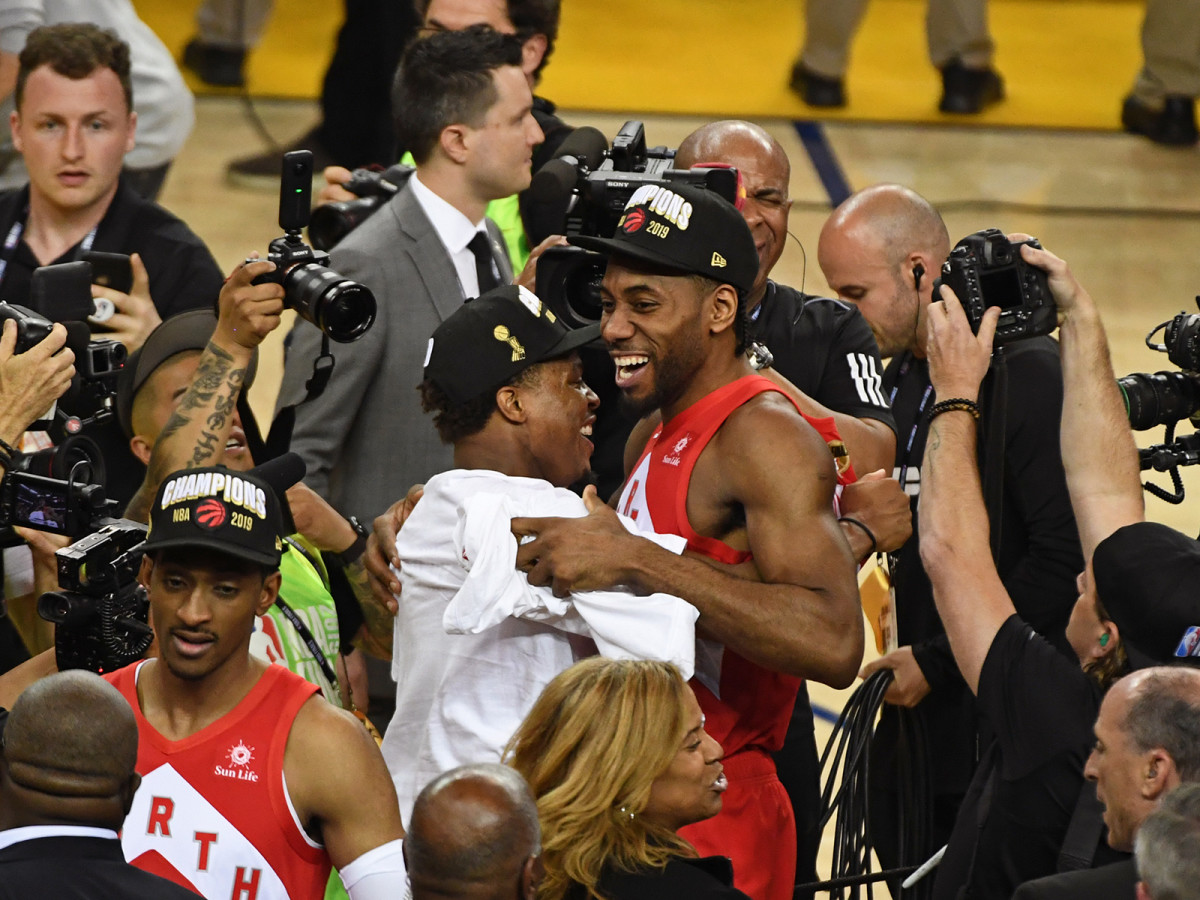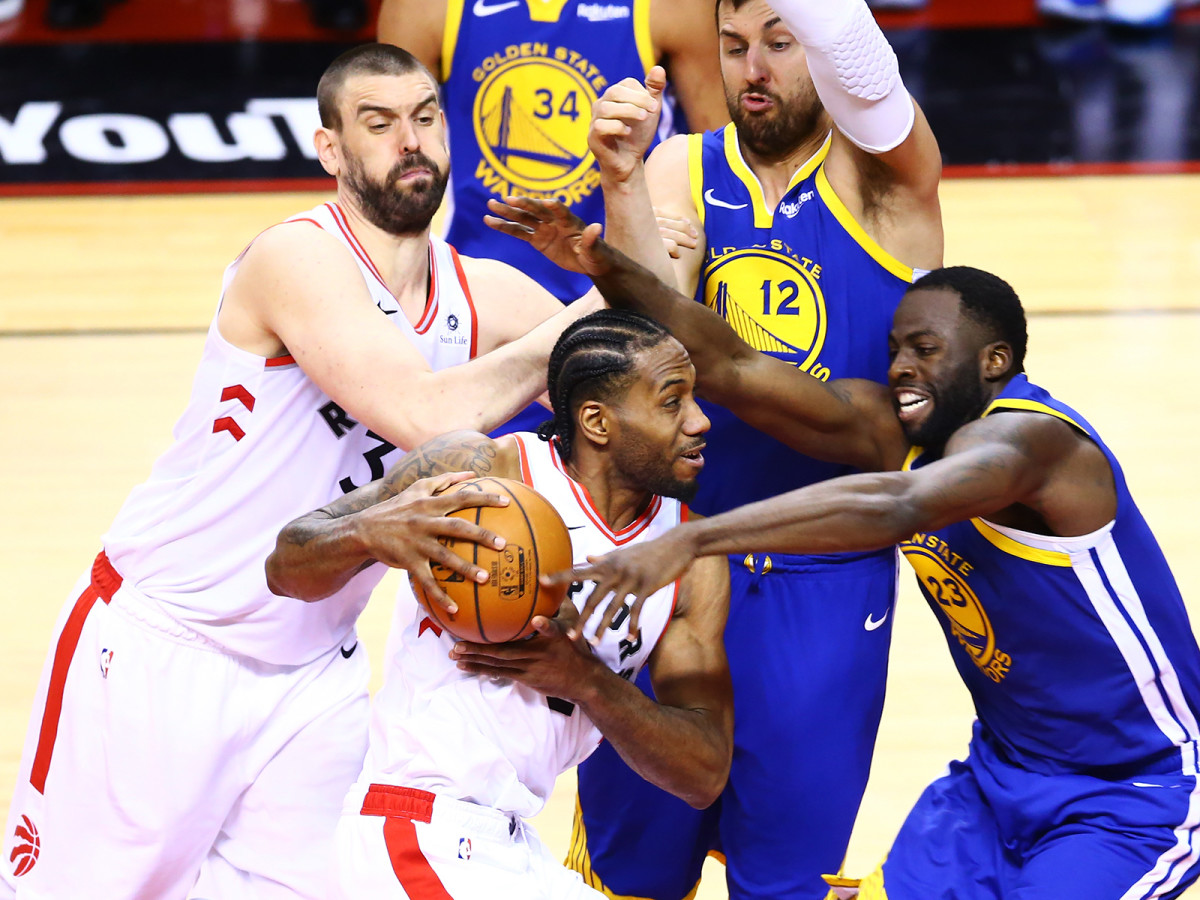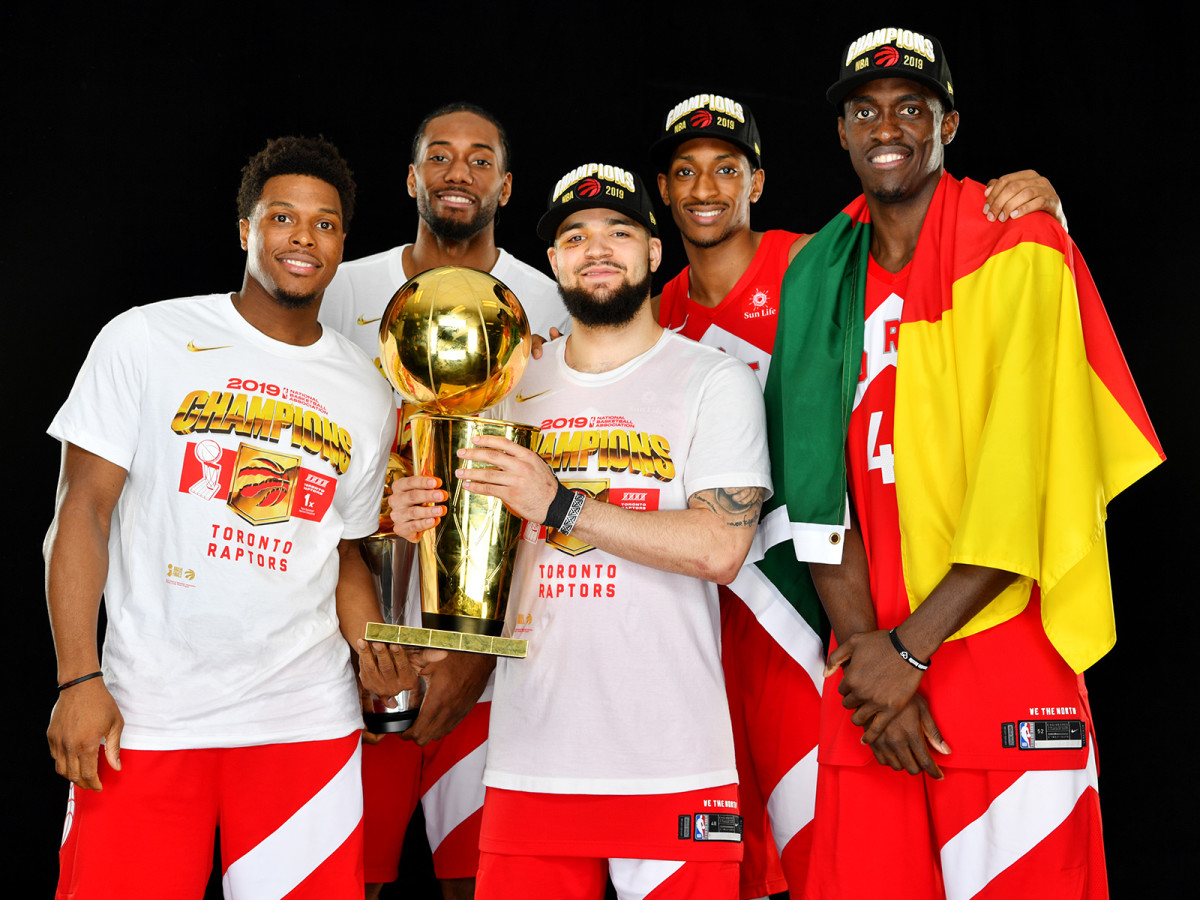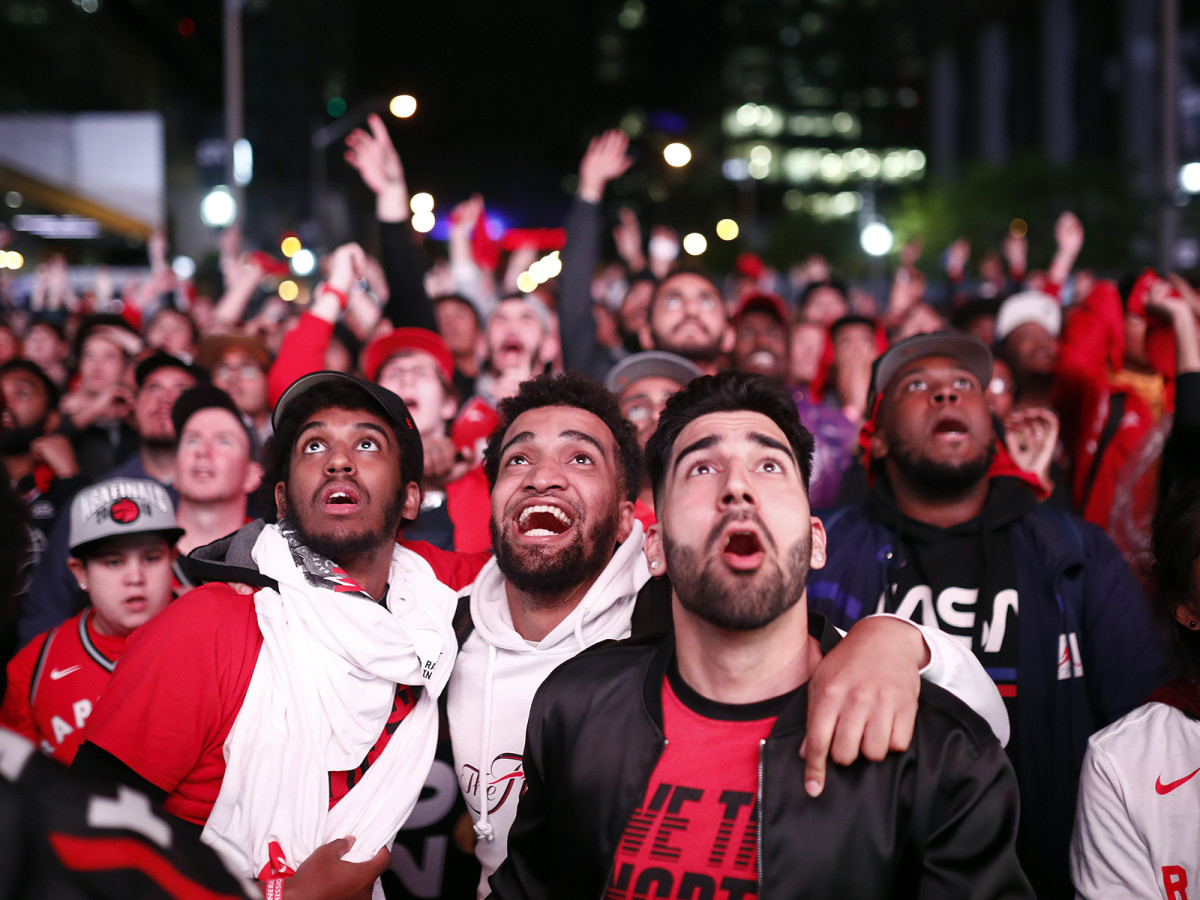We The Champs: Kawhi, Masai and the Legend of the 2019 Raptors

OAKLAND, Calif. — About six weeks before the Raptors won the first NBA title in franchise history, they were down 2–1 to the Sixers in the second round. On the heels of a 21-point loss in Game 3, Toronto looked cooked. Pascal Siakam was questionable for Game 4 with a calf injury, the Sixers were playing at home with a chance to go up 3-1, and the entire basketball media was quietly preparing its stories on Kawhi Leonard’s free agency. "Stay the course," said Raptors guard Fred VanVleet of the team's approach at that point. "Make a couple adjustments. Don't overreact. Don't lose your s---. Trust that you're the better team, and that will show over time."
Toronto won that Game 4 101–96 and regained control of the series. Kyle Lowry had been 2 of 10 for seven points in Game 3, but he bounced back with 14 points and seven assists. Marc Gasol chipped in with 16 points and Serge Ibaka had 12. Leonard did the rest. He had 39 points on 13-of-20 shooting—including a massive three over Joel Embiid with 1:01 to play—along with 14 rebounds and five assists.
It seems like a small moment now—smaller than Leonard’s mind-boggling game-winner in Game 7 a week later, smaller than Toronto stringing together four straight wins against the Bucks in the Eastern Conference finals after going down 2–0, and smaller than the Raptors stunning the NBA in six games against the Warriors—but that Sunday afternoon in Philadelphia was the first clue that something might be different this spring. The cycle would became familiar by mid-June: the Raptors are tested, the Raptors are doubted, and then the Raptors respond.
Now the Raptors are champions. There may be qualifiers attached to one side of the story in the Finals—Golden State was without Kevin Durant for all but 12 minutes of the series, and Klay Thompson went down in Game 6 as well—but the Raptors seized their opportunity and never let go. Even as the Warriors fought back and played like champions themselves, Toronto had answers for everything. Sometimes they came from Leonard, other times it was VanVleet bombing in threes to kill Golden State's momentum, or in Game 6, it was Lowry, who finished the Finals off with 26 points on 9 of 16 shooting with 10 assists, and Siakam, who added 26 points and 10 rebounds of his own.
The night of Game 6 ended with Leonard on the podium accepting his Finals MVP award, nodding toward the Larry O'Brien trophy, remembering 12 months of work "trying to get that Larry O'B over there." Twenty minutes later, Leonard was drenched in champagne and walking into an interview room telling a Raptors staffer that he might get sick from being that cold and wet. His teammates, meanwhile, Facetimed Drake while celebrations continued in the locker room. Gasol video chatted with Mike Conley. Lowry entered the press conference room, sat among reporters, and asked VanVleet what it's like to be an NBA champion. VanVleet said that most of all it was great to see Lowry lift that trophy after years of playoff criticism. Earlier in the celebrations they all had been on the court, where Gasol spotted VanVleet and stopped an interview to dance around Toronto's sixth man and ask how VanVleet was even walking given how big his balls had been during Game 6. VanVleet finished with 22 points in the closeout game, including five critical three-pointers.
In the end, the Raptors will be remembered as a team that came together late, survived when they needed to, and then shocked the world when it mattered most—they finished the playoffs on an 8–2 run against the teams with the best record in each conference, and they entered each series as massive underdogs. Leonard led all NBA players in minutes, points, rebounds, steals, free throws and field goals in the postseason. He’s now responsible for denying three-peats to LeBron’s Heat (his Spurs beat Miami in the 2014 Finals) and Steph’s Warriors. He was named Finals MVP each time.

More than anything, the Toronto run was a testament to the power of ambition. Twelve months ago, president Masai Ujiri decided that Toronto deserved better than a series of valiant regular seasons and familiar playoff disappointments. He traded his best player, DeMar DeRozan, after three straight 50-win seasons. He fired his head coach, Dwane Casey, just a month before Casey was named Coach of the Year. The Raptors then rested Leonard, the superstar they got in return for DeRozan, for a full quarter of the regular season. They called it “load management,” and as Ujiri explained in February, the strategy went beyond coddling a star. “I know [fans] want to see him every game,” he said. “But the guy had an injury last year. We had to do things to help him recover not in one game, not in one month. The goal is the playoffs. The goal is, ‘How do we compete at the end?’ ”
After Game 4 VanVleet said that Leonard was hitting “eff-you shots” in the road win that seemed to break Golden State halfway through this series, but really, this team has been in eff-you mode for 12 months. Even at the trade deadline, the Raptors were on pace to win 59 games when they flipped depth on the bench to add veteran Marc Gasol at the top of the roster. That deal meant going big when the rest of the league was going small, betting on another impending free agent and doubling down on the all-in strategy that informed the entire season. As GM Bobby Webster admitted midway through the playoffs, all of this was a huge gamble. “Everyone would like to say they know,” he said. “But you never know. You’re changing massive pieces."
If the alternative to an all-in bet was another year of underwhelming returns, Toronto's choice was clear all year. Which is to say, charmed as it may have seemed when Kawhi’s series-winner was bouncing around the rim against Philly or when VanVleet was burying the Bucks with historic shooting nights, this Raptors run was not made possible by magic or destiny, but realism—about what this team had, where everyone wanted to go, and what it would take to get there.
Whether it was mental toughness, coaching, defense, or stars at the top of the roster, Ujiri and Webster didn’t just eliminate the flaws that doomed the team in the past; all those weaknesses eventually became strengths during this playoff run. "We had five exits in the playoffs," Webster says. "We had three in a row to Cleveland, obviously that's a championship team. So you learn a lot about yourself. You learn about your decision-making. You learn about the types of players you need in these moments."
One player, in particular, was exactly who Toronto needed.
Within days of the July 2018 trade that brought Kawhi Leonard and Danny Green from the Spurs, there was speculation that Leonard, a year away from free agency, did not intend to stay in Toronto past this season. When he arrived at media day, Leonard said of his future, “My focus is on this year.” And even early in his Raptors tenure, the team wasn’t sure how comfortable he was. Says Webster, “He’d been in one place for eight years. We’ve all probably been through it personally, with the first big move of your life. You’re getting your bearings. Finding out how to get to work. Where you like to eat.”
As VanVleet says, “It’s a drastic change. Danny was telling us, in San Antonio, they didn’t really talk. It’s different. They're older. Timmy didn't really talk. Here, we talk. We joke. We laugh.”
In time, dynamics began to change. The team made fun of Leonard’s nightmarish laugh that went viral at media day, there were jokes about his impending free agency, and over time he became part of the group. “He’s a normal dude,” VanVleet says. “He makes jokes just like the rest of us.” At one point near the end of the season, Nurse, a former head coach in the G League, went on an extended digression about what he’d learned with the Rio Grande Vipers. It was quiet in the film room except for Nurse, when Kawhi finally boomed in to interject, “Coach, you talking ’bout the G League? The G League?” Says VanVleet, “Basically, ‘Let’s wrap this story up. ” The entire room burst out laughing.
It’s all been part of the process as Leonard embraces his role at the forefront of the Raptors. He rarely gives interviews, and his group media sessions can be laughably literal, like when he was asked what a title would mean to Canada and responded, “I’m really not sure. You would have to ask someone on the street or one of our fans.”
As Green explained the source of Leonard's focus in the aftermath of Game 6, he said, "Not having social media. Totally tuning out. Avoiding [reporters] as much as possible in the summertime. He's mastered it." All that matters to his teammates is that he’s happy behind the scenes. "It took some time,” Green said early in the playoffs. “But he’s enjoying the moment. He’s feeling comfortable. He’s feeling like this is his team.”
After the past two months, Kawhi may also be feeling like this is his league. His numbers were significantly better in the playoffs—from 26.6 points, 7.3 rebounds and 49.6% shooting in the regular season to 30.9 points, 9.2 rebounds and 49.2% shooting in the playoffs—and his impact was downright staggering. His last-second three against the Sixers capped a 41-point Game 7 outburst and the most points scored by any player over the course of a seven-game series since Michael Jordan in 1993. Against the Bucks, he changed the series when he began to guard Giannis Antetokounmpo. The likely-MVP had been averaging 27 points per game for Milwaukee through the first two games of that series, in which Leonard guarded him on 12.7% of Bucks possessions. In the final four games, all Raptors wins, Leonard guarded him roughly 45% of the time. On those possessions, Antetokounmpo scored a total of 25 points and missed 20 of 30 shots.
During the Finals, Leonard averaged 28.5 points, 9.8 rebounds, and 4.2 assists. Steph Curry called him “amazing.” Andre Iguodala called him a “machine.” Draymond Green initially said that Leonard doesn’t look like LeBron or Durant—a throwback to when Durant called Leonard a “system” player back in 2014—but by the end of the series Leonard had been so dominant that Green was forced to clarify his stance. “He still don’t look like them,” said the former Defensive Player of the Year. “But he’s getting it done. Give him his credit. He imposed his will and all the other guys followed.”

If Leonard has a signature as a player, it’s his poise. He is not the most explosive star in the NBA, he's not the most skilled, and he's not the biggest. What makes him special is the ability to control his movement, use his power, get whatever shot he wants, and make it all look routine. The defense can never speed him up or slow him down, and his approach almost never changes.“I don’t think you ever rattle Kawhi,” Draymond said midway through the Finals.
"He's as even-keeled maybe as I've ever seen," Nurse said during the Bucks series. "That spreads pretty quickly around the locker room. And on top of that, he makes a lot of big plays. The even-keeled guy is out there making big plays, and the rest of the guys usually get settled in fairly quickly." Later, before Game 5, Nurse admitted that earlier in the series he told his players they should head to Oracle looking to get one win. "F--- that," Leonard told the locker room. "Let's go get them both."
It’s hard to know how much credit any individual should receive for a teamwide transformation, but almost every team eventually conforms to the qualities of its best player. In the year that Toronto’s identity became rooted in resilience and an almost supernatural detachment from pressure, Kawhi has been a reminder that not all leadership looks the same. Showing everyone how to work can be just as effective as telling them. And for that matter, Kawhi’s media strategy might be rubbing off just the same. After Toronto eliminated Philly, Siakam was asked to offer a prediction for the Eastern Conference finals. “I learned from Kawhi,” he said. “He told me not to answer those questions. I’m going to take a trick from Kawhi’s book on this one.”
As dominant and inevitable as Leonard seemed by the end of the playoffs, it has to be noted that the spontaneous outbursts from his supporting cast were just as memorable. VanVleet was 7 of 44 before welcoming a newborn son midway through the Bucks series. He finished that series going 14 of 17 from three-point range in three straight wins, telling the world to "Have babies and let it fly." In the Finals, he averaged 32.3 minutes, averaged 14 points, guarded Curry, and punctuated the run with his massive Game 6.
Or Lowry. He spent most of this playoff run managing games and driving teams insane with hustle plays and drawn charges. Then, every few games, he’d come up with the sort of performance that reminded everyone he was once a perennial All-Star. "Nobody deserves it more than that guy," VanVleet said in the wake of Lowry's outburst in Game 6. "What he's been through [in past playoff losses], the slander he takes... I'm so happy for him."
The story of the supporting cast began when Leonard was sitting out 22 regular season games this year. As a result, Nurse used 22 different starting lineups, and only one more than nine times. The challenge created opportunity that allowed Siakam to blossom into the NBA's most improved player, while VanVleet became, in Danny Green's words, "The best sixth man in the world." Once again, the Raptors turned a perceived weakness into a strength. “That’s why we are where we are right now,” Green said. “Because of how much we’ve had to adjust and how battle-tested we are as a group.”
Toronto’s ability to shape-shift throughout the playoffs was a credit to both players and the coaching staff. “Our IQ is really high,” says Lowry. “Our starting five might be up there with any starting five, IQ-wise. It gives us an advantage to be able to figure [things] out and be able to communicate. Knowing opponents, studying habits, knowing rotations. It makes it a lot easier to help and talk. We have a coverage, we can switch it, we can do this, we can do that. Easy.”
Nurse, too, was quick to make reads and react. Sometimes that meant deploying a surreal box-and-one defense on Curry in Game 2 (it failed, but it almost worked), but more often they were subtler tweaks. He balanced Ibaka’s and Gasol’s minutes with ease. He stuck with Green throughout a shooting slump early in the playoffs and was rewarded when Green made half of his 22 postseason threes in the first three games of the Finals. And then, in the middle of the Warriors series, he decided to switch his second half starters and begin every third quarter with Green on the bench and VanVleet alongside the starters. “It gives us kind of a double push,” Nurse said. “Two guys that can take it off the bounce, two guys that can run the team.” After being blown out in the third quarter of Game 2, Toronto won the third quarter in both Games 3 and 4 at Oracle.

Nurse has always been willing to try anything. Toronto assistant Phil Handy spent several years with LeBron's Cavs teams that once haunted these Raptors, but he also played for Nurse 20 years ago, in England, on a Manchester Giants team that finished its season 45–7. “He was young, very knowledgeable,” Handy says. “He’s the type of guy that learns on the fly. He's constantly pushing himself. And obviously, he's got his history coaching the G League and winning championships there."
Granted, it may be impossible to read this quote without imagining Leonard interjecting, but Nurse’s past coaching experience really did prepare him for this Raptors season and all the lineup upheaval that came with it. “In the [G League] you have so much change in personnel that you end up having to do that much more than you would at this level,” he said. "You're always getting disrupted. [The G League] was a chance to work at those skills more than you would anyplace else in the world. The other thing I always say, everybody that has been in the G League is a little better off for it. It's a really great place and really great people."
Nurse had the perfect temperament for this veteran team. “I think Nick honestly yelled at us twice the whole year,” Lowry says. “That’s legit: twice the whole year. And that’s a long season to only yell at a team twice. That’s just Nick and Kawhi and Marc and Danny—everyone is just kind of going out there and staying even-keeled.”
It’s that cast of supporting characters that will enhance the legend of this Raptors team as the years pass. This team was working with a Hall of Fame star at the peak of its powers, but it also had a rookie head coach, young players coming into their own, and veterans who entered every playoff series knowing it might be their last, best shot at a NBA title. “It’s not the typical mix," Handy says, "in terms of what people would think is a championship caliber team. But Masai and Bobby have done a phenomenal job of trying to put some young talent in here around some talented older guys. It’s just a special group of guys. They’re playing for each other. And they’re playing for this country, man".
Canada was part of this story, too. Before Game 1 of the Finals, Jalen Rose looked around at the Toronto crowd in shock. “Props to Masai Ujiri,” Rose said. “The last six years, all of that has elevated.” Rose was on a Raptors team that finished 33–49 in 2004–05. The crowds he played for were nothing like what the world just saw in the Finals. “It is awesome,” Rose said of the progress. “How many basketball teams does California have? Lakers, Kings, Warriors, Clippers. Canada, as a nation, they have one team. There’s 20,000 people in here. There’s 40,000 people outside. The only time you get that in the United States is a parade.”
The frenzy went beyond Toronto. After the 105–92 road win in Game 4, hundreds of Raptors fans lingered and then gathered in the corner of Oracle’s lower bowl. There were flags, there were old-school jerseys, there were homemade signs and there were lots of delirious hugs. It looked like the end of a college football game, except instead of an alma mater they were singing “O, Canada.”
Nav Bhatia has attended every Raptors home game since the team arrived 24 years ago. He was at Oracle as well, and at one point Warriors security recruited him to help keep the Raptors fans under control. Asked what this title run meant to him, he said, “It’s not for me. It’s for all these Canadians from coast to coast.” Another fan at Oracle, a 30-something man named Khalid, had traveled to Oakland from Toronto just like Bhatia. “I can go back 20 years,” he said, “When Damon Stoudamire came in.” Asked whether it was crazy to remember those years when the team was a joke around the league, Khalid’s friend interjected, “We were [a joke] like two weeks ago!” As the Raptors crowd turned to leave after Game 4—only after Oracle ushers forced them out—Bhatia was asked about a potential free agency pitch to Leonard. He waved his hands at all the visiting fans. “Look at all this,” he said. “That’s the pitch. That’s the love. He’s going to be King of Canada.”
It's true, amid the celebrations, Kawhi's free agency still looms as an unknown. But whether he stays or goes, the impact of the past few months will resonate regardless. At various points during the Finals, an estimated 40% of Canadian households were watching the Raptors. Outdoor watch parties were held in more than 60 cities across the country. At the PGA Tour’s Canadian Open, fans broke into chants of “Let’s Go Raptors.” When he eventually won the tournament, golfer Rory McIlroy was seen walking off with a Lowry jersey over his shoulder.
In a recent poll conducted by the Toronto Star, Canadians between 18–35 reported watching more of NBA Finals than the Stanley Cup this spring. A contending Toronto team obviously skews those results, but among other factors, Canada’s immigration policy has helped fuel the growth as well. “One of the phenomenons you see,” says Dan MacKenzie, managing director of the NBA in Canada, “is that when new Canadians come to this country, they’re coming from countries where basketball is really popular. Countries like China, like the Philippines. Basketball becomes a currency for them to adapt to life [in Canada].”

It helps, too, that the Raptors are among the most diverse organizations in the NBA. Ujiri is from Nigeria. Webster grew up in Hawaii. The head of sport science and unofficial czar of load management, Alex McKechnie, is Scottish–Canadian. Players hail from Cameroon, Spain, Congo, Philadelphia and Los Angeles. “It really is a cross-section of the way Toronto looks,” MacKenzie says. “Masai’s built his organization that way. It reflects the city and, in a lot of ways, the country and where the country’s going.” Meanwhile, immigration has also helped fuel growth among youth basketball in Canada, a culture that continues to expand its footprint both domestically and throughout the American college ranks.
Years ago, before Masai, before Kawhi, before Lowry and before DeRozan, Vince Carter arrived in Toronto and spawned a new generation of basketball fans. He made the Raptors successful locally. He made them relevant internationally. Vinsanity activated passions that Canada never knew existed. “That resulted in a boom,” MacKenzie says. “Canada’s now the number two country in the world for producing NBA athletes.” As he explains that history, it’s easy to think back to those Raptors teams with Carter and Tracy McGrady and remember how cool they seemed. It’s not surprising that the Carter era spawned an entire generation of fans, and if that sparked growth in the grassroots basketball culture, that makes sense, too. Of course, Carter and McGrady never made it past the second round.
If those Raptors teams sparked a boom, think about what this one just did.
